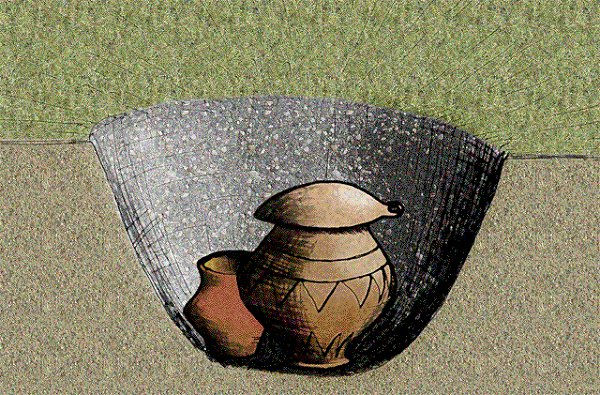Urnfield Bronze & Iron Age Burials
- Sylvia Rose

- May 7, 2024
- 5 min read
Updated: May 8, 2024
Bronze Age burial ruins from the Urnfield Culture are found at Marburg Botanical Garden in Hesse and Franzhausen-Kokoron, Austria. The Urnfields get the name from the practice of cremating bodies, storing the ashes in urns and burying them in cemetery fields.
See also:
The Urnfield group evolves from the preceding Tumulus Culture and the Nordic Bronze Age. A formidable force, the Tumulus culture is coming to the end of its multi-national domination as the Urnfield people flex their muscles c. 1300 BCE and into the Iron Age.
People of the Tumulus culture trade with Scandinavia and Atlantic Europe, with wares reaching Mycenaean Greeks in the south, another dominant power. Trade establishes and fortifies networks by land or sea.
The Urnfield take over northern trade. Amber and metal ornaments or tools are common. Other trade desirables include spices, wine, fabrics, dyes, gemstones, pottery, utensils, raw metal, timber, weapons, slaves, livestock, pottery, deific idols, news and gossip.
People of the Urnfield Culture get their name from the burial tradition of cremating their dead and putting the ashes into pottery urns. Urns are placed in barrow or pit style graves. Sometimes ashes of the deceased are sprinkled in the burial pit without the urn.
Grave pits are round to oval or square, with a diameter 0.4 (1.3 ft) to 1.0 m (3.3 ft). There is no grave architecture. Urn and grave goods are placed in the grave, usually filling the pit. In earlier burials, some pits don't contain cremated remains, but stones treated with fire.
Grave goods, personal items, good luck tokens, beads and precious stones might also be found in a burial site. As metallurgists Urnfield people are among the catalysts of the the Iron Age in the north.
Development of the Urnfield burial style is a gradual progression. Urnfield burials occur in some regions of Europe c. 2300 BCE, a thousand years before they become widespread.
While archaeological evidence appears by 1600 BCE, scholars agree the rise of the Urnfield Culture or Urnenfelderzeit is c. 1300 BCE. A burial site at Franzhausen-Kokoron, Austria, dating to 1030 BCE, yields the type of grave goods found in Urnfield cremation burials.
Graves may be in shallow pits or barrows and contain one to several ceramic vessels, in which are found signs of cremated human remains or food offerings for the afterworld; these may be preserved as un-burnt animal bones.
Among the total of 403 graves in Austria, 268 urn graves are found, including 24 double burials. Some are damaged or scattered as the site is found during highway construction. Still, over 350 individuals are identified in the gravesites so far.
At the Austrian dig excavators find 529 metal objects. Bronzes are intact or deformed by fire. Many dress pins are revealed, especially vase-headed and onion or poppy-headed pins; various kinds of fibulae (brooches): one-piece wire bow, spectacle and harp fibulae.
Also found are arm and neck rings and various small rings (including a golden Lockenring) and decorative bronze rivets. A Lockenring or lock ring is a rare Middle Bronze Age gold ring dating to c.1600 - 1400 BCE.
The Lockenring is a single link in a royal chain or collar. Like arm bands and bracelets, lock rings are used as currency in business and trade, or given as royal gifts. Celtic Ring-Money evolves from these items, which may evolve from the production of ingots.
Extraordinary finds include belt buckles and earrings with blue glass beads, small disc and ring beads of bone, mollusc and stone. Mollusc shell jewelry is made shells of land snails (Zebrina detrita). Several graves contain knucklebones (astragali), used for divination.
Numerous knives, tanged knives (Griffplattenmesser), full-hilted knives (Vollgriffmesser) and some iron knives are found. Also among the items are awls, fishhooks, crescent-shaped razors with ring handle, an arrowhead, sewing needles, and spindle whorl of bone.
In sites such as Marburg traces of human settlement date back to the Würm Ice Age c. 50,000 ya. Scrapers and other tools are found at several sites, suggesting settlements of Neanderthal and later people.
During the Neolithic Age, people transition from hunter-gatherer lifestyles to working the land. Natural conditions of the Amöneburg Basin with its fertile soils are well suited to agriculture.
In the 5th millennium BCE settlements are founded and cultures such as the Rössen or Michelsberg hold battles in the area. Later Corded Ware and Bell Beaker cultures move in. Numerous burial mounds date from this time.
Remains of a grave from the Late Bronze Age is in the New Botanical Garden. A complex on the nearby Schanzenkopf can be attributed to the late Merovingian period c. 700 AD.
Botanical Garden
Besides burial mounds and Bronze Age graves, the Botanischer Garten Marburg (Botanical Garden) has several lovely attractions:
Alpinum - rock garden representing plants from the high mountains of Europe, western Asia, the Himalayas, Australia, and New Zealand.
Arboretum - focusing on conifers, including Sequoiadendron giganteum and Metasequoia glyptostroboides, as well as alders, ash, birches, ginkgos, hazels, maples, oaks, deciduous poplars, sycamores, and willows, representing both native and exotic species.
Fern collection - 80 fern species.
Forest - spring-blooming plants including Anemone, Gagea, Iris, Narcissus, Pulsatilla, Scilla, and Tulipa.
Medicinal and useful plants - including cereals and other carbohydrates, succulents, vegetables, fiber plants, tobacco plants, rubber plants, and dye plants.
Heather and rhododendron garden - numerous heather and rhododendron species including Calluna vulgaris, Erica carnea, Erica cinerea, and Erica tetralix.













